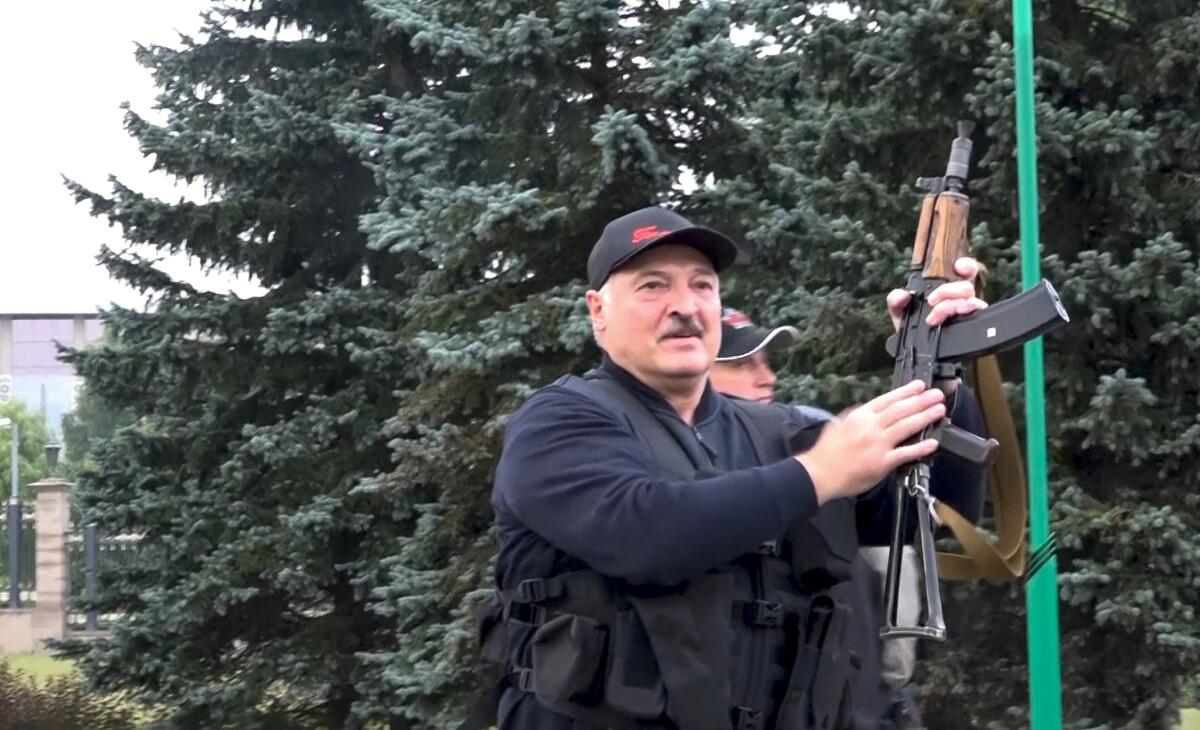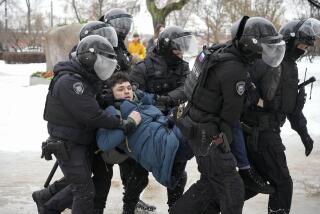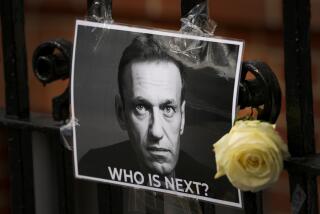In a shift, Belarus leader seeks to stem protests gradually

- Share via
MINSK, Belarus — When Belarusians filled the streets to protest what they called a fraudulent election that kept authoritarian President Alexander Lukashenko in power, the blunt repressions came first.
Police used tear gas, flash grenades and beatings on the crowds in the capital of Minsk and elsewhere. They detained thousands, with hundreds injured and at least three deaths.
But the heavy-handed measures in the days after the Aug. 9 election seemed to produce the opposite effect, emboldening more protesters, triggering strikes at state-run factories and forcing authorities to back off.
With the protests now in their third week — including rallies that brought out an estimated 200,000 people in Minsk on the last two Sundays — the 65-year-old president is shifting tactics. He is moving to squelch the demonstrations gradually with vague promises of reforms mixed with threats, court summonses and the selective jailing of leading activists.
Observers say the moves by Lukashenko to buy some time likely will see him holding onto power for now, although he almost certainly will face more challenges amid a worsening economy and simmering public anger.
“Lukashenko has enough resources to control the situation. He is predictably stifling the protests, but the picture is changing,” said Valery Karbalevich, an independent political analyst. “The economy is becoming Lukashenko’s main enemy. His regime is running out of funds.”
Throughout his 26-year rule, the former state farm director has maintained Soviet-style controls over the economy and relied on cheap energy and other subsidies from Russia, which has a union agreement with the nation of 9.5 million.
Public weariness with Lukashenko’s iron-fisted rule, augmented by his cavalier dismissal of the COVID-19 pandemic as a “psychosis” and the bruising economic fallout from the outbreak, has fomented broad discontent.
The official result of the election that said Lukashenko won a sixth term with 80% of the vote triggered the largest protests Belarus has seen, along with unprecedented strikes by blue-collar workers who were his loyal base of support. Opposition figures sought a political solution by forming a Coordination Council to engineer a transition of power and new elections.
Police and other security forces, who have stood aside after the initial crackdown and allowed rallies by tens of thousands, are slowly starting to detain demonstrators again, but without the dramatic violence.
On Monday, officers handed court summonses to more than 40 protesters on charges of holding unsanctioned rallies and disobeying authorities, and the next day the Interior Ministry reported 51 detentions.
Prosecutors opened criminal inquiries against activists who set up the Coordination Council. Two of its leading members received 10-day jail terms Tuesday for organizing unsanctioned protests, and several others were summoned for questioning over their roles in the council.
Authorities also have moved to intimidate factory workers involved in the strikes. Lukashenko has warned participants that they could lose their jobs and the plants could be closed temporarily, hurting those who didn’t take part.
Hundreds of officers of the domestic security agency, which still goes by its Soviet-era name of KGB, have inundated the plants to warn workers they could be fired or face criminal charges.
“The KGB agents have flooded the factory, and they have managed to intimidate many,” said 43-year-old Vladimir Ogarevich, who works at the Minsk Tow Truck Plant, whose workers heckled Lukashenko when he visited. “But our wages are shrinking, life is getting harder and we can’t subsist on fear. We will keep striking.”
Several strike leaders, including Sergei Dylevsky, who joined the Coordination Council, have been detained on charges of organizing unsanctioned protests. Other activists also face such threats.
Pavel Latushko, a former culture minister and ambassador to France who joined the protesters, had his house splashed with red paint and received threats.
“The authorities’ scenario is clear: They are trying to stem the wave of protests by using force, slowing the processes and demotivating the leaders,” he said.
Still, the daily rallies by undeterred protesters are continuing.
“There is no more fear,” said 20-year-old student Ruslan Dubko, who showed bruises on his back and his arms that he said came from police striking him repeatedly during his detention earlier this month. “My parents were being afraid and patient throughout their lives. But I’m going to resist after they stole my first election.”
Aside from the threats, court orders and selective arrests, there have been darker, more violent episodes. The bodies of two opposition supporters were found hanged in forests. Although the police declared the deaths to be suicides, the opposition has contested the conclusion.
“Lukashenko is following a simple and primitive scenario — to hang on to power at any cost,” said Alexander Klaskousky, an independent Minsk-based analyst. “He will have to change course only if political protest widens and more factory workers join the labor action.”
In a bid to stymie demands for a new election, Lukashenko suggested a constitutional reform process that would lead to a new vote down the road.
“Lukashenko is a seasoned demagogue who can imitate a dialogue in order to shift focus,” Klaskousky said. “It allows the authorities to win time, try to drown the protests in chatter and channel the process in a desired direction.”
When thousands of demonstrators marched toward his official residence on Sunday, the presidential office released a video showing Lukashenko landing in a helicopter nearby and brandishing a Kalashnikov rifle. He called the protesters “rats” as he inspected riot police guarding the residence. His youngest son, 15-year-old Nikolai, walked nearby, also carrying a rifle.
“It was supposed to show the strength of a fearless Lukashenko, but it had an opposite effect, and most people saw it as a reflection of fear of a weakening and erratic leader,” Klaskousky said.
While Lukashenko may succeed in clinging to power for now, Klaskousky predicted that the president will see his authority weaken dramatically as more challenges arise over the failing economy.
“Even if they manage to temporarily stifle the protests by factory workers with repressions, they will flare up anew in a half-year or a year,” Klaskousky said.
He noted that neighboring Russia, which sees Belarus as a bulwark against Western expansion and an important conduit for its energy exports to Europe, prefers a weakened Lukashenko to advance its long-term goal to merge the two countries.
“Moscow is interested in having a weakened and exhausted Lukashenko, who would accept any plan of integration and unification,” Klaskousky said. “But in parallel to that, the Kremlin is starting to look for an alternative candidate who would guarantee union ties and replace the unpopular leader who is trying to scare the world and his own people with an assault rifle and barbed wire.”
He predicted the Kremlin could instigate a “palace coup” if protests and strikes grow.
Further erratic moves by Lukashenko could also prompt Moscow to look for other options, Karbalevich said.
“The Kremlin has already cut subsidies to Minsk and may ponder alternative scenarios if Lukashenko continues to make mistakes and lose control over the situation,” he said.
More to Read
Sign up for Essential California
The most important California stories and recommendations in your inbox every morning.
You may occasionally receive promotional content from the Los Angeles Times.










